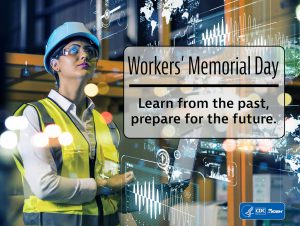Workers’ Memorial Day, 2019: Statement by John Howard, M.D., Director, NIOSH
Posted on by
Workers’ Memorial Day, observed annually on April 28, recognizes workers who were injured, became ill, or died because of exposures to hazards at work. In 2017, work-related injuries claimed the lives of 5,147 U.S. workers according to the latest figures from the Bureau of Labor Statistics (BLS). This represents less than a 1% decrease in the fatality rate from the previous year. We can do better.
Together, the occupational safety and health community—including government, labor, academia, and industry—must address both the persistent risks to workers and proactively mitigate novel risks that are arising in a complex, evolving work environment being shaped by technological innovations such as nanotechnology, additive manufacturing, and robotics; shifting employment relationships with no one “standard” work arrangement; and changing demographics. This is the future of work.
Often, what we know about the safety and health aspects of emerging technologies and work arrangements lags behind our understanding of the impact on workers. We need to continue to research and evaluate these changes to better understand the potential benefits and risks and how to manage them in the workplace. This can be challenging; for example, there is a lack of standard classification codes for robot-related injuries, making it hard to identify how often injuries may be occurring. However, using keyword searches of the BLS Census of Fatal Occupational Injuries database, NIOSH researchers identified 61 robot-related deaths between 1992 and 2015.
One of the ways NIOSH is addressing worker safety around emerging technologies is through its Center for Occupational Robotics Research. The Robotics Industry Association reports that in 2018 U.S. companies are using more robots than ever before. The greater use of robots across various industries can be viewed as both positive and worrisome. Use of a machine, robot, or drone to do a hazardous activity instead of a human worker, can reduce injuries and illnesses. On the other hand, the close proximity of robot and human workers may pose a hazard that will need risk mitigation measures. The Center provides scientific leadership to guide the development and use of occupational robots that enhance worker safety, health, and wellbeing.
As part of this effort, NIOSH recently joined Advanced Robotics for Manufacturing (ARM). ARM is a diverse consortium of organizations from industry, academia, non-profit, and government, working together to revive manufacturing with an eye toward new opportunities for a 21st century workforce who are prepared to work collaboratively with robotic technologies in a safe environment. As a member of ARM, NIOSH is contributing its perspective on issues related to worker safety and health and research needs associated with advancing industrial applications.
While we manage the transition to a new future, we continue to confront the opioid epidemic gripping our nation. This epidemic took the lives of 47,600 people in 2017 according to the Centers for Disease Control and Prevention. The effects of the opioid epidemic are not isolated to work or home environments, and the potential for addiction may be preceded by workplace injuries.
Approaching the crisis from an occupational perspective, NIOSH developed a framework that looks at workplace conditions that can be risk factors for medically prescribed opioid use becoming opioid misuse. The framework details the approach of looking at workplace conditions that can be risk factors for medically prescribed opioid use becoming opioid use disorder. It also focuses on protecting responders from exposure to illicit drugs, including fentanyl, and developing methods of rapid detection of dangerously potent opioids in a workplace, as well as information about effective decontamination of workplaces.
The emerging opioid epidemic has left its mark on some industries more than others. In a 2018 MMWR report, NIOSH researchers detailed occupational patterns in opioid-involved overdose deaths and found construction workers are over-represented among both prescription opioid-related and heroin-related overdose deaths. The construction industry has one of the highest injury rates when compared to other industries. In some settings, opioids have commonly been prescribed to construction workers to treat the pain caused by occupational injuries.
Construction workers also face a persistent and entirely preventable risk: falls. Falls are the number one killer in the construction industry accounting for nearly 40% of job-related fatalities. Alarmingly, fatal falls across all industries are at their highest levels in the 26 years since the Bureau of Labor Statistics began tracking workplace fatalities.
One way we are addressing the toll of construction falls is through a National Campaign to Prevent Falls in Construction, a combined effort by NIOSH, OSHA and CPWR – The Center for Construction Research and Training. The cornerstone of this campaign is the National Stand-Down to Prevent Falls in Construction, which will occur May 6–10. During this week, NIOSH encourages employers to stop work and speak directly to their workers about fall hazards to reinforce the importance of proper fall prevention and promote safety and health on the job.
This April 28th we pause to remember the workers who did not come home safe and healthy, and recommit ourselves to empowering employers and workers to create safe and healthy workplaces through research.
Posted on by

